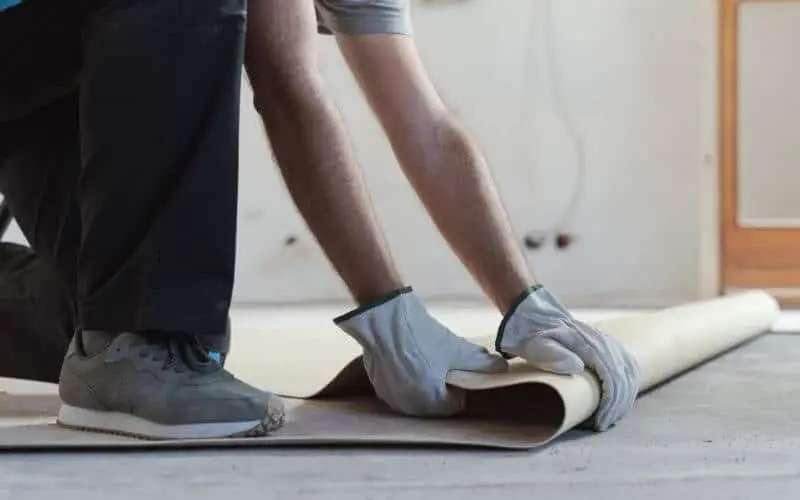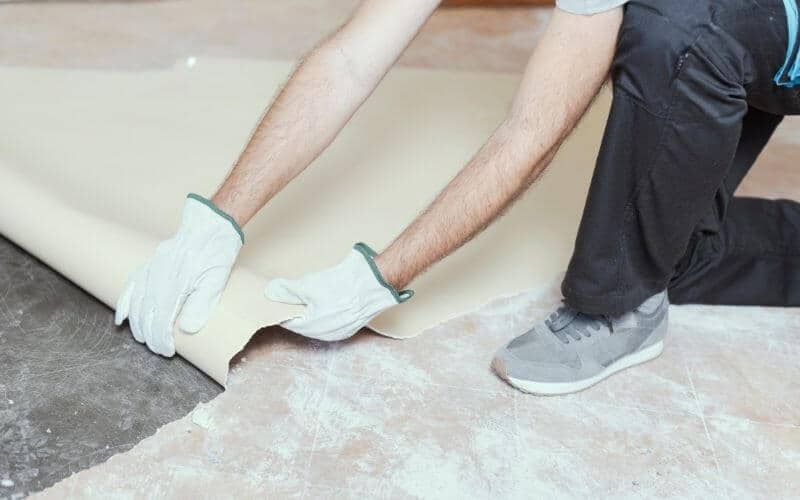Like vinyl flooring, linoleum has an adhesive that grows stronger over time, making it difficult to remove.
This is probably because linoleum is made up of natural products like linseed oil, limestone, pigments, and cork.
In cases where you can’t afford a professional to remove your worn-out linoleum from the floor, this post on how to remove linoleum backing from wood floor becomes quite helpful and instructional.
When these products are fused and affixed on a wood floor, we realized that it is pretty challenging to get them off without the help of a professional.
To remove linoleum backing from wood floor, you need to remove the top layer as well as remove the underlying layer by applying heat.
Related: How to clean discolored linoleum flooring
Things You Will Need
- Utility knife
- Floor scraper
- Heat gun or hair dryer or Wallpaper steamer
- Oscillating multitool
- Isopropyl alcohol
How To Remove Linoleum Backing from Wood Floor
Table of Contents
Below is a step-to-step guide on how to remove linoleum backing from the wood floor. Before you get started, make sure to get the material outline above on standby.
You might also want to keep your bluetooth speaker by the sideline – music should probably help make the work easier.
Step 1: Use the Outline of the Tiles to Score
This method is easier than scoring the flooring into strips of about 6 to 12 inches wide. Most linoleum features a tile pattern; thus, you can easily use the outlines of the tiles as general guides to show where to score. Using your utility knife, proceed carefully, making sure not to cut through the material.
Step 2: Remove the Top Layer of the Linoleum
As mentioned earlier, removing the top layer of the linoleum is way easier than removing the adhesive. You can easily tear out the linoleum first before getting to the actual work.
Using your scraper or the edge of your oscillating multitool underneath one of your score marks. Push forward to bring out the adhesive. Keep working in small sections until you have removed the entire first layer.
Step 3: Remove the Underlying Paper Backing or Adhesive by Applying Heat
It is almost impossible to remove the underlying paper backing or adhesive with just the scrapper or the edge of the oscillating multitool.
To remove the stubborn part of the adhesive, apply heat to the floor using either the heat gun or hair dryer or a Wallpaper steamer to the floor.
Once the adhesive is softened, scrap it up using your utility knife at a 45-degree angle. Be careful not to gouge the subfloor as you work. Move section by section until all the backing and adhesive have been removed.
For more stubborn spots that cannot be removed with heat, apply some isopropyl alcohol or paint thinner to the area and allow the solvent to sit according to the manufacturer’s instructions.
Proceed to scrape away the remainder of the adhesive, again working a 45-degree angle.
You can opt-out of removing the linoleum and lay a new material directly on top of your current linoleum. This might, however, raise the floor by at least one-eighth of an inch.
Read: Jute backing on hardwood floor
Tips on Removing Linoleum Backing from Wood Floor
1. Remember that the process of removing linoleum from the wood floor is a gradual process. Get the right tools and get to work with no rush.
2. Do not attempt to remove linoleum that contains asbestos. If you suspect your linoleum containing asbestos (Asbestos-containing linoleum may be black or dark in color, or it may have a black adhesive), get a professional to remove it as the use of heat soften the glue could warp and damage the wood floors beneath the linoleum.
3. Get protective materials like work gloves, long pants, sturdy shoes, knee pads, and a face mask when removing linoleum from a wooden floor.
4. You may want to consider renting a 10-yard dumpster when removing linoleum. Sheets of linoleum are too heavy to bag up with your regular trash—especially if you’re working in a large room.
5. Avoid overheating the adhesive so as not to damage the floor. For instance, you can let the heat run continuously for about 15 minutes, then turn it off when it becomes too hot.
Allow it to cool for about 60 minutes and turn it back on. Always switch it off while you are scraping to prevent overheating!
Related: How to remove rust from linoleum floor
Conclusion
Remember that removing linoleum from a wooden floor is a slow and gradual process. If you attempt to rush through it, you might end up damaging your floor or, even worse, sustaining injuries in the process – we are pretty sure you don’t want your house project to become a visit to the ER.
We hope that this post has provided all the needed information on how to remove linoleum backing from the wood floor.
Once you have successfully removed the linoleum from your floor, you can decide on the flooring option that will serve your needs best.

